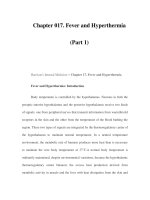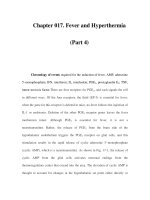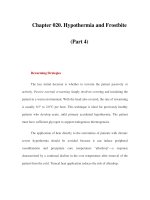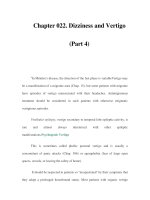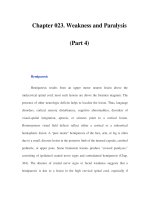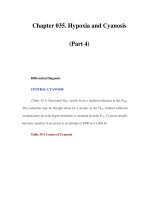Chapter 071. Vitamin and Trace Mineral Deficiency and Excess (Part 4) docx
Bạn đang xem bản rút gọn của tài liệu. Xem và tải ngay bản đầy đủ của tài liệu tại đây (14.08 KB, 5 trang )
Chapter 071. Vitamin and Trace Mineral
Deficiency and Excess
(Part 4)
Thiamine Deficiency: Treatment
In acute thiamine deficiency with either cardiovascular or neurologic signs,
100 mg/d of thiamine should be given parenterally for 7 days, followed by 10
mg/d orally until there is complete recovery. Cardiovascular improvement occurs
within 24 h, and ophthalmoplegic improvement occurs within 24 h. Other
manifestations gradually clear, although psychosis in Wernicke-Korsakoff
syndrome may be permanent or persist for several months.
Toxicity
Although anaphylaxis has been reported after high doses of thiamine, no
adverse effects have been recorded from either food or supplements at high doses.
Thiamine supplements may be bought over the counter in doses of up to 50 mg/d.
Riboflavin (Vitamin B
2
)
Riboflavin is important for the metabolism of fat, carbohydrate, and
protein, reflecting its role as a respiratory coenzyme and an electron donor.
Enzymes that contain flavin adenine dinucleotide (FAD) or flavin-mononucleotide
(FMN) as prosthetic groups are known as flavoenzymes (e.g., succinic acid
dehydrogenase, monoamine oxidase, glutathione reductase). FAD is a cofactor for
methyltetrahydrofolate reductase and therefore modulates homocysteine
metabolism. The vitamin also plays a role in drug and steroid metabolism,
including detoxification reactions.
Although much is known about the chemical and enzymatic reactions of
riboflavin, the clinical manifestations of riboflavin deficiency are nonspecific and
similar to those of other B vitamin deficiencies. Riboflavin deficiency is
manifested principally by lesions of the mucocutaneous surfaces of the mouth and
skin (Table 71-1). In addition to the mucocutaneous lesions, corneal
vascularization, anemia, and personality changes have been described with
riboflavin deficiency.
Deficiency and Excess
Riboflavin deficiency is almost always due to dietary deficiency. Milk,
other dairy products, and enriched breads and cereals are the most important
dietary sources of riboflavin in the United States, although lean meat, fish, eggs,
broccoli, and legumes are also good sources. Riboflavin is extremely sensitive to
light, and milk should be stored in containers that protect against
photodegradation. Laboratory diagnosis of riboflavin deficiency can be made by
measurement of red blood cell or urinary riboflavin concentrations or by
measurement of erythrocyte glutathione reductase activity, with and without added
FAD. Because the capacity of the gastrointestinal tract to absorb riboflavin is
limited (~20 mg if given in one oral dose), riboflavin toxicity has not been
described.
Niacin (Vitamin B
3
)
The term niacin refers to nicotinic acid and nicotinamide and their
biologically active derivatives. Nicotinic acid and nicotinamide serve as precursors
of two coenzymes, nicotinamide adenine dinucleotide (NAD) and NAD phosphate
(NADP), which are important in numerous oxidation and reduction reactions in
the body. In addition, NAD and NADP are active in adenine diphosphate–ribose
transfer reactions involved in DNA repair and calcium mobilization.
Metabolism and Requirements
Nicotinic acid and nicotinamide are absorbed well from the stomach and
small intestine. Niacin bioavailability is high from beans, milk, meat, and eggs;
bioavailability from cereal grains is lower. Since flour is enriched with the "free"
niacin (i.e., non-coenzyme form), bioavailability is excellent. Median intakes of
niacin in the United States considerably exceed the recommended dietary
allowance (RDA).
The amino acid tryptophan can be converted to niacin with an efficiency of
60:1 by weight. Thus, the RDA for niacin is expressed in niacin equivalents. A
lower conversion of tryptophan to niacin occurs in vitamin B
6
and/or riboflavin
deficiencies, or in the presence of isoniazid. The urinary excretion products of
niacin include 2-pyridone and 2-methyl nicotinamide, measurements of which are
used in diagnosis of niacin deficiency.
Deficiency
Niacin deficiency causes pellagra, which is mostly found among people
eating corn-based diets in parts of China, Africa, and India. Pellagra in North
America is found mainly among alcoholics; in patients with congenital defects of
intestinal and kidney absorption of tryptophan (Hartnup disease; Chap. 358); and
in patients with carcinoid syndrome (Chap. 344), where there is increased
conversion of tryptophan to serotonin. In the setting of famine or population
displacement, the occurrence of pellagra results from the absolute lack of niacin
but also the deficiency of micronutrients required for the conversion of tryptophan
to niacin (e.g., iron, riboflavin, and pyridoxine). The early symptoms of pellagra
include loss of appetite, generalized weakness and irritability, abdominal pain, and
vomiting. Bright red glossitis then ensues, followed by a characteristic skin rash
that is pigmented and scaling, particularly in skin areas exposed to sunlight. This
rash is known as Casal's necklace because it forms a ring around the neck; it is
seen in advanced cases. Vaginitis and esophagitis may also occur. Diarrhea (in
part due to proctitis and in part due to malabsorption), depression, seizures, and
dementia are also part of the pellagra syndrome—the four Ds: dermatitis, diarrhea,
and dementia leading to death.
